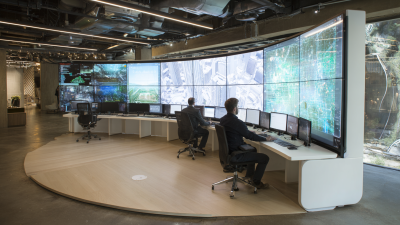Choosing the right display panel LCD for your business needs is a critical decision that can significantly impact your operations, branding, and customer engagement. With a plethora of options available in the market, understanding the key factors that differentiate one LCD panel from another is essential for making an informed choice. Whether you are looking for a display for advertising, kiosks, or internal communications, the specifications and features of the display panel can vary widely, affecting everything from image quality and viewing angles to power consumption and durability. In this guide, we will explore the various aspects to consider when selecting a display panel LCD, including resolution, size, technology, and intended usage, empowering you to make a choice that aligns perfectly with your business requirements.

When selecting an LCD display panel for business needs, understanding the different types available on the market is crucial. Mainstream driver chips like LCD DDIC (Display Driver Integrated Circuit) and TDDI (Touch Display Integrated Driver) are essential in determining the functionality and efficiency of various display panels. These driver chips enhance the performance of the displays, allowing businesses to choose models that best fit their operational requirements. According to market reports, the global interactive display market is set to grow from $45.32 billion in 2023 to an astounding $86.44 billion by 2030, highlighting the increasing demand for advanced display solutions.

Moreover, with the burgeoning mobile phone LCD screen market projected to climb from approximately $11.78 billion in 2024 to $38.26 billion by 2033, it becomes clear that businesses must remain competitive by utilizing cutting-edge display technologies. The integration of augmented reality (AR) and virtual reality (VR) technologies is also on the rise, signaling the importance of investing in next-generation display platforms that can foster deeper engagement with users. As the landscape of display technology evolves, businesses need to be equipped to make informed choices that align with future trends and consumer preferences.
When selecting an LCD display panel for your business needs, evaluating resolution and brightness is crucial for achieving an optimal visual experience. High resolution ensures that images and text appear sharp and detailed, which is particularly important in environments where clarity matters, such as design studios or control rooms. A display with a higher pixel density can enhance the viewing experience by providing more detail, allowing for more precise visual tasks and reducing eye strain during long hours of use.

Brightness, on the other hand, greatly impacts visibility in various lighting conditions. A brighter display can be more effective in well-lit offices or outdoor settings, where ambient light may otherwise obscure content. The integration of high dynamic range (HDR) technology in some panels also enhances contrast and color accuracy, making visuals more lifelike. As businesses increasingly adapt to digital communication methods, investing in displays that offer optimal resolution and brightness will enhance overall productivity and comfort.
When selecting an LCD display panel for professional use, assessing color accuracy is paramount. Color accuracy refers to how well the display reproduces the colors intended by the designer or content creator. For businesses that rely on precise visuals, such as graphic design, photography, or video production, panels with a wider color gamut and high color fidelity are essential. Look for displays that cover a significant portion of color spaces like sRGB, Adobe RGB, or DCI-P3, as these specifications indicate the panel’s ability to reproduce a broader range of colors accurately.
In addition to color accuracy, contrast ratios play a crucial role in the display's performance. The contrast ratio measures the difference between the darkest black and the brightest white that a panel can produce. A higher contrast ratio translates to deeper blacks and more vibrant colors, allowing for enhanced detail in both shadows and highlights. For tasks that involve critical viewing, such as editing or monitoring, a panel with a high static contrast ratio can significantly improve the clarity and depth of images. Therefore, when choosing an LCD display, it is important to evaluate both color accuracy and contrast ratios to ensure the panel meets the specific demands of your business.
| Panel Type | Resolution | Color Accuracy (%) | Contrast Ratio | Response Time (ms) |
|---|---|---|---|---|
| IPS | 1920 x 1080 | 99% | 1000:1 | 5 |
| VA | 2560 x 1440 | 95% | 3000:1 | 4 |
| TN | 1920 x 1080 | 85% | 1000:1 | 1 |
| OLED | 3840 x 2160 | 100% | Infinite | 0.1 |
| Mini-LED | 3840 x 2160 | 98% | 15000:1 | 2 |
When selecting an LCD display panel for your business, the size and aspect ratio are critical factors that can significantly impact productivity and user experience. According to a recent report by MarketsandMarkets, the global LCD display market is expected to reach $121.4 billion by 2025, highlighting the increasing reliance on these technologies across various industries. Businesses need to consider the environment in which the display will be used—larger screens typically enhance visibility in communal areas, while smaller displays may be more appropriate for individual workstations.
Aspect ratio plays an equally important role in how well the information is presented. The standard 16:9 aspect ratio is prevalent in most modern displays, providing a good fit for videos and presentations. However, for applications that require multi-tasking or display of detailed data, such as design or data analytics, a 21:9 ultra-wide format can be advantageous. A survey conducted by Display Supply Chain Consultants indicates that ultrawide monitors are gaining popularity, with a projected increase in usage by over 30% in corporate environments in the next three years. Thus, choosing the right size and aspect ratio tailored to specific business needs is essential for maximizing efficiency and enhancing the overall user experience.
This chart demonstrates the preferred sizes and aspect ratios of LCD display panels used in various business environments, providing insights into what configurations are most commonly chosen.
When selecting an LCD display panel for business applications, conducting a cost-benefit analysis of various technologies is essential for maximizing return on investment (ROI). Different LCD technologies, such as IPS, TN, and VA, offer distinct advantages and disadvantages that can influence both initial costs and long-term performance. For instance, IPS panels typically provide superior color accuracy and wider viewing angles, making them ideal for design and marketing environments, albeit at a higher price point. Conversely, TN panels, while less expensive, may not deliver the same level of visual quality, potentially affecting user experience and productivity.
In addition to panel technology, factors such as energy efficiency and durability should be incorporated into the ROI analysis. Displays with lower power consumption can significantly reduce operational costs over time, contributing to a faster payback period. Furthermore, the longevity of the display can affect overall investment; selecting a panel that is built to withstand the rigors of a business environment can lead to fewer replacements and maintenance expenses.
By carefully evaluating these aspects, businesses can make informed decisions that align with their specific needs and enhance their overall performance.






